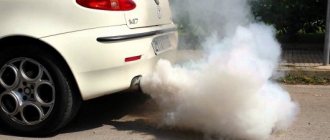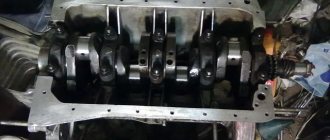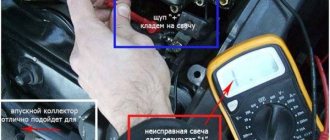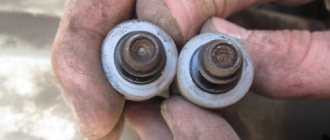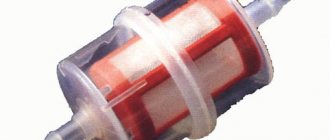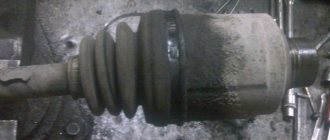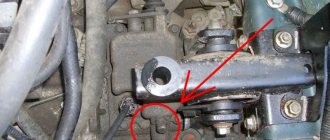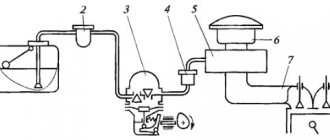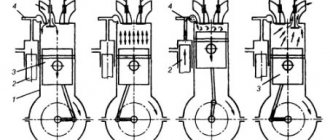Repost and the information will always be at hand ✅
White smoke from the tailpipe is normal as long as the engine is cold. If the white steam does not dissipate after warming up, serious problems with the engine are likely. Most often, such a sure sign indicates a breakdown of gaskets that have a crack inside or on the block itself. Additionally, the appearance of the oil in the pipe changes; it becomes whitish, similar to an emulsion.
Repairs must be carried out without delay, since the cause of white smoke vapor is always serious. The car wears out and the likelihood of individual modules breaking down increases.
In the article we will look at all the possible reasons why white smoke comes out of the exhaust pipe when the engine is “cold” or “hot”, when starting the engine, how to determine the malfunction, how to prevent it. I promise it will be interesting!
What is exhaust
Exhaust is a combination of steam, nitrogen mixed with carbon dioxide. If the internal combustion engine (ICE) and the systems adjacent to it are functioning properly, then these emissions are colorless, so when the engine is running, an invisible stream comes out of the pipe. The purification of the released products is ensured by a catalyst that eliminates gases when leaving the collector.
In some cases, changes in saturation are normal. You can ignore this symptom if it occurs constantly during a cold start or in cool weather. Then there is no point in looking for a fault - the change in texture occurs under the influence of the laws of physics. In other cases, the cause must be found and eliminated in a timely manner.
For reference! Exhaust is the removal of waste gas from an internal combustion engine cylinder during the stroke of the working piston.
Possible causes of depressurization
Improper operation of the vehicle and improper care of its systems result in undesirable consequences. Loss of tightness occurs in the following cases:
- the cylinder head is installed with violations of the installation technology, with non-compliance with the tightening force of the fasteners (uneven distribution of the load occurs when the gasket is pressed);
- destruction/wear of the paronite gasket between the cylinder head and the block;
- through cracks in the block between the channels and cylinders.
We recommend: Motul oil
Some problems can be identified after visual inspections, so we recommend periodic inspections for vehicles at risk. These include old cars and cars with intensive use.
There is no point in postponing the solution to identified faults, as the consequences will be a violation of the thermal conditions of the engine, difficulties with lubrication and further progress with defects. This will be followed by rapid wear of parts and mechanisms or complete failure of components.
How to check why white smoke is coming from the exhaust pipe of a gasoline engine
You should do the following immediately. Open the hood, remove the dipstick and carefully look at the color and condition of the engine oil. After all, if water gets into the oil, it is bad for the heart of the car.
Next, place a white napkin in the exhaust pipe for 15 seconds (the engine should be running). If white smoke appears due to high humidity, the napkin will dry without leaving any traces. If oil gets into the cylinders of the internal combustion engine block heads, the napkin will contain greasy stains. By the way, in this case the smoke may have a light bluish tint.
If coolant gets there, the stains on the napkins will be yellowish or blue, plus there will be a sour smell. In this case, the smoke will be thick, even if the engine warms up for a long time. Additionally in the expansion tank:
- you can notice an oil film on the surface of the antifreeze;
- carbon monoxide will be felt from the coolant container;
- You can see small bubbles inside the tank;
- When starting the internal combustion engine, the fluid level rises. If the power unit is turned off, the level returns to its original state;
- the pressure in the engine cooling system increases. To check, push the radiator hose when the engine is turned on.
Foreign liquid can enter the cylinders either through cracks in the block or head, or through a deformed gasket. In the latter case, the internal combustion engine additionally “troits” (it shakes) - when one or more cylinders malfunction, the operation of the engine is unstable under any load. It can even affect the car's braking system.
“Punctured” cylinder head gasket
If there is a very small crack in the cylinder head, a pressure test will be required. If the crack is large, it can lead to water hammer in the motor, which will result in a rather expensive repair.
Attention! If there are signs of antifreeze getting into the cylinders, then the car can only be used until a trip to the service station, because the coolant, when mixed with the oil, greatly worsens its properties. And this, in turn, increases the wear of the power unit significantly.
Reason #2
If strong white smoke comes from the exhaust pipe in warm seasons or when the engine is warm, this may indicate that coolant has entered the cylinders.
Steam is formed because there is water in the liquid, which also evaporates. Quite often it can be confused with oil smoke. In order to clarify, you can carry out a simple check in the old way. Warm up the engine and place a piece of paper near the muffler. If water is thrown out and not oil, then over time the leaf will dry out and there will be no oil stains on it. So let's move on. Coolant in the cylinder can appear not only due to a damaged gasket, but also due to the formation of cracks in the block or cylinder head. Sometimes this can cause exhaust gases to enter the cooling system. You can check this very simply: unscrew the cap of the expansion tank and look at the liquid. If there is a film on it or a distinct exhaust smell, then the problem has been identified.
Causes of white smoke from a gasoline engine
The main module of a car equipped with an internal combustion engine is the exhaust system. It is entrusted with the function of removing waste combustion products from the chambers. But this is not the only function. The system regulates the noise level and reduces the visibility of the exhaust. When the latter appears, you can notice disturbances in the operation of the car.
Another good article: Black smoke from the exhaust pipe: on gasoline, carburetor, diesel, injector, reasons, what to do
White smoke from their exhaust pipe in winter is normal.
Please note that the occurrence of the above problem is not a malfunction in the following cases:
- White smoke occurs when a cold engine warms up at a temperature around 0 degrees and disappears after a while.
- White smoke when starting preheated time for 20 minutes.
- In extreme cold, white smoke comes out all the time.
Let's take a closer look at all the reasons for the appearance of white smoke and what it means.
In the cold
Car owners confuse the concept of smoke and steam. The latter, which occurs when the engine is cold, indicates increased humidity inside the system. If you warm it up, the liquid will condense and become visible, even in warm weather.
I note that condensation often appears during short trips around the city, when the exhaust system does not warm up properly (I personally saw that about a liter of water was drained). Significant volumes of water may appear at the cut of the pipe under the trunk. As the module reaches the required temperatures, the position stabilizes and condensation disappears. To prevent this, drive for at least 30 minutes once a week, or simply warm up the car.
Condensation with white smoke is most often normal.
If the ambient temperature is less than 10 degrees, steam appears even when the engine is well warmed up.
At fairly low temperatures from -20 to -25 degrees, the smoke becomes rich white and quite dense. The last indicator is dependent on the cold; the lower the level, the greater the concentration. It's like steam coming out of a person's mouth during cold weather. But this doesn’t happen if it’s summer outside.
On a warm engine - on a hot one
If the internal combustion engine is warmed up and white smoke still appears, coolant has probably entered the cylinders. Antifreeze contains water, which does not have time to completely evaporate during combustion of the fuel mixture. Because of this, white saturated steam is formed.
The hue of the cloud depends on several factors:
- composition of the cooling mixture;
- weather;
- intensity of lighting on the street.
Sometimes the exhaust turns blue and appears oily. It is very easy to distinguish it from the water one. The latter dissipates well in the wind and disappears almost immediately in the air. If the composition contains oil, the cloud will linger for a long time and will look like fog, with a bluish tint.
Oil from the exhaust pipe indicates a serious problem
Advice! A simple test helps determine whether the exhaust mixture contains oil. To do this, after the internal combustion engine has fully warmed up, the exhaust hole is closed using a sheet of paper. After 10-15 minutes, when the water dries, if oil was present, smudges will remain.
The cooling component is able to penetrate into the cylinder if the gasket is damaged or a crack forms in one of the system modules. With such defects, the work of the car’s heart is distorted, the exhaust is thrown into the cooling system and this provokes smoke.
Any violations associated with the formation of white smoke from the exhaust pipe must be eliminated. It is important to establish the cause of their occurrence and eliminate the violation. It is possible that the defect is associated with the following problems:
- The thermostat is malfunctioning;
- The fan switch sensor and the module itself do not work;
- The tightness of the radiator, hoses and connections is broken.
The reason for the appearance of white smoke from the exhaust pipe varies, but it is not recommended to operate the car if such a defect is detected. The problem can progress, causing disruption of other modules. Against this background, wear of important parts accelerates; water-oil emulsion has a bad effect on the condition of the machine. Then a complete maintenance or major overhaul of the engine will be required after just a few hundred kilometers.
On startup
This rarely signals serious problems in the operation of the main module of the car - the engine. Smoke is caused by accumulated steam inside the exhaust system. This happens when you start the engine and press the gas, and water often drips from the exhaust pipe.
All the described phenomena are typical for cool weather with high air humidity, when it is cloudy or rainy outside. Completely normal - the problem goes away on its own after the system warms up. There is clearly a violation if the phenomenon persists during the heating process.
What other reasons could be associated with the release of white smoke?
The fact is that sometimes antifreeze can get into the cylinder due to a damaged head gasket or microcracks.
Defects in the operation of the power unit may be caused by the penetration of exhaust gases into the system responsible for cooling. This is fundamental to understanding the cause of white smoke appearing from a car's exhaust pipe.
Maybe it's all about the filters?
As strange as it sounds, a possible problem with the appearance of white smoke from the exhaust pipe of a car can be filters. Which are responsible for the cleanliness of the air in the power unit. This has already been proven and is considered an indisputable fact.
A dirty filter makes it difficult for clean air to pass freely. This creates an excess of fuel. As a result, “smokiness” increases. Moreover, along with white smoke, another problem may appear. Black smoke coming out of the car chimney. But this is a completely different story, the reasons for which it is advisable to highlight separately.
Summary
Of course, problems associated with smoke from the exhaust pipe, as a phenomenon, need to be treated using technical methods. These are direct reasons. If the defects are caused mainly by overheating of the power unit, you need to pay attention and get rid of malfunctions in the engine cooling system.
The thermostat may have failed or there may be problems with the fan switch sensor. Sometimes the fan itself refuses to work. What else could be the reason why there is smoke? Sometimes partial depressurization of the radiator occurs, but more often the connecting hoses fail. Problems with traffic jams occur less frequently.
Malfunctions resulting in white smoke from the exhaust pipe
Experienced car enthusiasts are well versed in faults, easily determine their causes and troubleshoot them. This is more difficult for a novice driver. Here's a list of possible problems:
- Filters clogged . Yes, that's a fact! It is because of dirty internal combustion engine air filters that you can get abundant and thick white smoke. This is due to the fact that the pores on the membranes are reduced, and accordingly, less air enters the system, with high fuel consumption. Over time, black smoke may appear.
- Technical malfunction of the internal combustion engine . White smoke from the muffler becomes dense even in the warm season. The problem appears at idle and when starting the engine. The reasons should not be looked for on the surface; the system should be examined at a service station.
- Antifreeze leak. The rotation of the engines becomes uneven, its speed decreases. Probably, the coolant level has dropped, and the engine speed jumps from 800 to 1200. The reason may be a malfunction of the cylinder block and camshaft head. Such elements are separated from each other by a cylinder head gasket. To protect against overheating, the system must be sealed. Problem with incorrect installation, bending or melting of the valve.
Oil in the antifreeze reservoir - Malfunctions in the carburetor.
- The spark plugs are clogged or their gap is incorrectly adjusted.
- Exhaust system clogged . You can inspect the exhaust pipe: if there is a red coating in the form of a ring near the edge, then you need to examine the condition of the engine pistons.
- Valve clearances incorrectly adjusted.
- Leaking injector nozzles.
- Cracks in the block or cylinder head . Part replacement required.
- Incorrect timing belt installation.
Another good article: Blue smoke from the exhaust pipe of a gasoline engine: reasons for how to remove it
But blue oil smoke from the exhaust pipe may indicate wear of individual elements. The engine piston must have a tight-fitting ring to prevent oil from entering the system. During operation, constant friction occurs, and the combustion chamber is located nearby, so parts wear out, fail, or change their rigidity. As the gap increases, the shade of the combustion products gradually fluctuates due to changes in the volume of the fuel mixture entering the system.
The main causes of the problem
Cold weather
If thick white smoke comes out of the exhaust pipe, the reasons may be different. Low air temperature is one of them. As noted earlier, water vapor is periodically present in the exhaust gas release device. It is located directly in the air, which enters the engine and is used to create a fuel mixture. On cool days, the hot steam coming out of the muffler instantly cools down, acquiring a light shade. Moreover, the higher the frost, the more distinct it will be.
Also, do not forget about condensation formed due to temperature differences. A similar phenomenon can be observed when the internal combustion engine has just been started, and moisture has accumulated in the exhaust system. The presence of the latter can be diagnosed by droplets of water concentrated along the edges of the muffler. It is extremely important to warm up the car well, and this must be done until the steam completely disappears. This is a mandatory operation, even if you don’t have far to go.
Filters
Surprisingly, the reason why thick light clouds appear from the muffler may be a clogged engine filter. There is significantly less air, and more fuel. All this leads to smoke, sometimes even black.
Technical problem
If the weather is warm outside, the engine is constantly idling before driving, and you don’t understand why strong white smoke is coming out of the exhaust pipe, it’s time to check your car for various types of breakdowns.
Antifreeze leak
If the engine speed begins to constantly “dance” and the coolant consumption has increased significantly, in 9 out of 10 cases the problem is that coolant is getting into the manifold. This is caused by the structure of the internal combustion engine, which consists of a head with a camshaft and a cylinder block. Between these elements there is a gasket. The design of the power plant itself must be completely sealed, since antifreeze constantly circulates through it, removing excessive overheating. If the cylinder head is installed incorrectly, small deflections form, or the oil seal burns out, this problem appears.
Wear of various elements
The piston of absolutely any engine has a special ring that prevents lubricants from entering. Due to constant friction and close proximity to the combustion chamber, such parts may lose their elasticity, harden, or even become unusable. All this contributes to an increase in gaps, which, in turn, causes engine oil to enter the fuel mixture.
Special power plant design
A large number of cars produced in the mid-90s are still driving on public roads. On some models, for example, cars of the Swedish brand SAAB, a valve with a vacuum hose was installed. The reason for the appearance of light, thick clouds is that transmission oil enters the engine through this throttle valve.
This phenomenon cannot be called dangerous for the internal combustion engine, but it will clearly affect its efficiency. Once inside, the fluid designed to lubricate all the moving parts of the gearbox contaminates the glow plugs, thereby causing a lack of spark, which negatively affects the performance of the cylinder.
Smells like gasoline
Smelling exhaust fumes is at least unpleasant, and not good for health, so this problem should be eliminated. In this case, thick white smoke appears, the level of antifreeze constantly drops, and fuel consumption for each kilometer traveled increases. The problem may vary.
Attention! In some cases, smelly gasoline that quickly evaporates from the tank indicates that it is time to change gas stations and choose a proven gas station. Probably, the fuel is simply diluted, which does not have the best effect on the operation of the engine.
If this simple action does not help solve the problem, you should inspect the engine itself or take the car to a mechanic. Possible problems and their elimination:
- Check spark plugs. First, you need to unscrew them and see where exactly the fuel does not burn and passes further through the gas exhaust system (manifold). The problem area can be identified by a damp or greasy spark plug.
- Intake system . It is possible that the chamfer of one of the intake valves in the combustion chamber may burn out. From this place, the fuel-air mixture enters the exhaust pipe. A mechanic can help fix the problem.
In the second case, it is necessary to change the rings on the valve pistons, sometimes the pistons themselves. This is labor-intensive and costly work related to the engine. But there is no need to rush into replacement. Initially, it is worth diagnosing the internal combustion engine, because there may be other problems.
If the oil seals do not fit well on the spark plug, the system may operate intermittently. Combustible materials enter the exhaust manifold. There is no need to worry if you smell exhaust fumes. If liquid is leaking from the muffler, it is probably condensation and not fuel, but the odor should not be pungent.
Blue smoke
If you find that blue smoke is coming from the exhaust pipe, the reasons for this may be more than serious and it is unlikely that you will be able to cope with it on your own, since in this case the “root of evil” will be in worn-out parts.
A bluish tint indicates that the oil is being burned along with the fuel. In this regard, it is necessary to find out how it gets there. Most often, such a “migration” occurs if:
- Oil seals are worn out. The reason for this could be untimely oil change or the use of a low-quality composition. In this case, old, dirty fluid, with debris and dirt, played the role of an oil seal. While you were driving with this oil, all systems worked normally, but as soon as the fluid was replaced with a new one, it flushed the system, and the oil seal became the filler neck.
- If you observe blue smoke from the exhaust pipe, the reasons may also lie in worn oil scraper rings that collect oil from the cylinder walls. If these elements are worn out, then fluid will accumulate in the form of compression rings during the stroke and compression process. In this case, it is recommended to check the compression.
Healthy! The smoke can be either transparent blue or rich white-blue. It all depends on the mode in which the engine operates, oil volume and other factors. The bluish smoke does not dissipate and leaves obvious marks on the “test sheet”.
It is also worth noting that blue smoke from the exhaust pipe, the cause (whether it is a diesel or a gasoline engine does not make much difference) of the appearance of which we have examined, is also accompanied by a high level of oil and fuel consumption, the consumption of which increases by 0.5 liters for every 100 km. And if we are talking about a turbocharged engine, then it is quite possible that the problem lies in a damaged turbocharger: the bearings are worn out or the rotor is sealed. In the latter case, it is most difficult to identify the malfunction, since the oil passes directly into the exhaust system, where it burns out.
We recommend: Motor oils and everything you need to know about motor oils for Lada Vesta
Healthy! If your car is equipped with a converter that cleans exhaust gases, then you may not see smoke, so the only sign of a breakdown will be “gigantic” gas consumption.
In addition, oil can enter the cylinders through the piston rings or gaps between valves and guides.
Also, if there is blue smoke coming from the exhaust pipe, the reasons may lie in:
- Worn elements of the cylinder-piston assembly (including the surface of the cylinders themselves).
- Incorrect engine repair technology.
- Piston skirt deformations. In this case, the motor will become very hot.
- Worn valve stems and guide bushings.
- Ignition system malfunctions.
- Rust that has accumulated in the cylinder or on the rings.
There have been more exotic cases. For example, if a machine has a manifold gasket installed, which at the same time serves as a channel gasket, then it is likely that it is leaking. As a result, antifreeze began to accumulate in the cylinder, passing through the intake manifold. In this case, you will notice that the pressure in the cooling system has stopped increasing, and the liquid level has noticeably decreased.
Healthy! If bluish smoke appears briefly or only during the warm-up process, this indicates that the damage to the CPG is minimal, but still requires close attention.
Owners of cars with an automatic transmission with vacuum sensors may experience a rupture of the regulator membrane, which will also lead to blue smoke. If the color of the steam is closer to black, then you should pay attention to other nodes.
Causes of white smoke from a diesel engine
The exhaust pipe of a diesel engine may emit white vapor for the following reasons:
- increased humidity in the muffler when starting and warming up the engine;
- Incomplete combustion of fuel inside the engine occurred. This is observed not only in a faulty engine, but also in cold weather;
- antifreeze got into the chamber.
If a diesel engine pipe emits white smoke, this is due to moisture inside the muffler - this is normal. At the moment the system starts up, the water simply flows out, and if this does not happen, the residue comes out after start-up in the form of lush, white balls. Water vapor should be completely eliminated after sufficient heating.
If the fuel mixture is incompletely burned, its ignition is delayed. Engine repair is not always required. There is a malfunction, with a high degree of probability, if the problem occurs in the summer.
There are other malfunctions that provoke such “symptoms” on diesel cars:
- the plunger pairs in the fuel pump are faulty;
- the spark plugs are malfunctioning;
- low pressure inside the cylinders;
- injection into the nozzles is carried out under high pressure.
Another good article: Blue smoke from the exhaust pipe of a gasoline engine: reasons for how to remove it
Such changes can provoke a violation of the fuel injection angle in the engine. The moment of its ignition in the cylinders is delayed, making it more difficult to start the car even when the internal combustion engine is warm. The car often jerks and the diesel engine runs wasted.
The performance of the engine noticeably decreases, it becomes difficult to accelerate, it takes a lot of time, fuel consumption increases, the engine reacts poorly to pressing the gas pedal.
The third reason why white smoke can come out of the exhaust system is dangerous for diesel engines is that antifreeze gets inside the system . The substance that penetrates the cylinders provokes the formation of sulfur oxide, which reduces engine performance. Most often, antifreeze gets into the engine due to wear of the head gasket or cracks in the head. In some cases, the intake manifold gasket is damaged, then coolant enters the combustion chamber through the fuel injection system. If you ignore the problem, then in the future the power unit may experience water hammer.
The car owner must understand that the problem must be identified in time, otherwise a water hammer will occur. There may be a malfunction of the connecting rods and then a major engine rebuild will be required.
What can the exhaust color say?
Based on the color of the exhaust gases, we can draw conclusions about the following violations in the operation of the engine:
- black exhaust – a combustible mixture over-enriched in fuel;
- blue exhaust – oil entering the combustion chamber;
- white exhaust means coolant has entered the cylinders.
One of the reasons for black exhaust is a too rich fuel mixture. An excess of fuel enters the cylinders, and it does not have time to completely burn during the engine cycle. Unburnt fuel products are emitted through the exhaust pipe in the form of soot particles. The causes of the problem may lie in both the injection system and the ignition system.
Often, an over-enriched combustible mixture is the result of severe contamination of the air filter, which leads to a significant lack of air for combustion. Perhaps the malfunction is due to incorrect operation of the nozzles or injectors and is associated with ineffective atomization of the mixture or “overfilling” of fuel. Often black exhaust smoke is accompanied by unstable engine operation and loss of power.
The uncharacteristic bluish or white color of the exhaust gases indicates the presence in the cylinders of those components that ensure the functioning of the engine, but under normal conditions remain isolated and do not participate in the combustion processes of the fuel mixture. This becomes possible if the tightness of one of the engine circuits - oil or cooling - is broken.
When foreign liquid enters the engine cylinders, its combustion products also give the exhaust gases a corresponding color. For example, the loss of engine oil is accompanied by a blue exhaust, and thick white smoke from the chimney is the result of coolant entering the combustion chamber.
How to eliminate white smoke
First you need to make sure that there is a violation, determine the color of the outgoing exhaust and check the level of coolant in the tank to prevent leakage. If there are smudges, car owners and repairmen do not advise driving the car.
The problem should be immediately eliminated on your own or contact a service station.
If you do not respond to a malfunction in a timely manner, the lubricant will mix with antifreeze and its properties will decrease by an order of magnitude.
If problems are identified, the vehicle should not be used. If dense balls of white smoke are pouring out of the chimney, it is only permissible to drive to the workshop. It is important to understand that the engine's life reserves are rapidly declining and delay will result in the need for expensive repairs.
In some cases, using a car is not recommended at all; parts wear out more actively, so it is worth using the service of a tow truck. If the engine runs through a mixture of water and oil, its modules break down beyond repair.
Video: What to do if white smoke comes out of the muffler
Watch a useful video on how to practically get rid of white smoke from the exhaust pipe.
When the muffler smokes white, there is a malfunction.
There are several reasons that cause white smoke to appear from a car's exhaust pipe. Most are associated with the presence of foreign impurities in the fuel-air mixture.
Antifreeze in cylinders.
The undisputed leader among problems is the ingress of coolant into the cylinders of the power unit. It is typical for all cars, regardless of whether a gasoline or diesel engine is installed. Once in the combustion chamber, the antifreeze evaporates and the vapors mix with combustion products. The resulting mixture enters the exhaust tract and passes through the muffler, creating a thick cloud of white smoke at the outlet.
Fault diagnosis.
It will not be difficult for an experienced motorist to carry out diagnostics. Necessary:
- Start the engine, warm up for 10-15 minutes;
- Take a sheet of white paper, apply it to the exhaust pipe (cover up to 50% of the diameter), hold for 10 seconds.
Conclusions are drawn based on visual analysis of the resulting spot. A wet trail without oil inclusions indicates that there are no problems (the cloud is formed exclusively by water vapor).
The presence of oil traces is a sign of a malfunction.
To ensure problems are identified, you should:
- Open the expansion tank or radiator cap. If the tightness of the channels of the cooling system is broken, combustion products enter the coolant, which is indicated by a characteristic odor.
- Monitor the level and quality of antifreeze in the system. If the seal is broken, the amount of liquid constantly decreases (topping up is required), contamination with oil and combustion products occurs (color changes, consistency is disrupted, foam forms), pressure becomes unstable (liquid is squeezed into the tank, ejection through the lid is possible).
- Check the quality of the oil. Antifreeze entering the cylinders is mixed with lubricants and penetrates the oil sump - an emulsion is formed, the properties of which do not provide lubrication of the parts of the power unit. A characteristic sign of a problem is foaming of the oil (foam is clearly visible on the dipstick and plug when checking the level).
- Inspect the spark plugs - traces of coolant on the electrodes, skirt, threaded part are visible to the naked eye.
How to prevent white smoke
What can the average driver do to minimize the risk of white exhaust? The level of antifreeze in the expansion tank should always be monitored. To do this, you can look under the hood or use special sensors (if any). The substance should not change its volume much or leave abruptly. If this is observed, there may be a coolant leak.
Antifreeze needs to be changed approximately once a year, but the tank should not be empty even during this period of time. Therefore, the component level is the first thing to check if exhaust smoke is coming from the pipe sideways.
Even with a significant daily mileage, the substance must be added very rarely and in small quantities. If a component is consumed irregularly, it is better to visit a service center and fix the existing problem.
Before removing white smoke from the exhaust pipe, you need to find out the true causes of its occurrence. They can be physical - the manifestation occurs due to environmental conditions (low temperatures) or is a consequence of a breakdown.
Dense exhaust generated due to deformation in the system is a cause for concern for car owners with gasoline and diesel fuel.
In both cases, the situation may become critical and the motor may fail.
The only thing is that you can ignore this sign in the cold season . The vapor density from the car engine increases until it warms up, and after the temperatures stabilize, the module works as expected. You also need to look at the color, black smoke from the exhaust pipe or gray smoke is more dangerous.
Repost and the information will always be at hand ✅
Strong smoke from the muffler - possible causes
Many people are familiar with the case when, after a long period of inactivity, a car suddenly begins to pour thick smoke from the exhaust pipe. It often disappears after warming up and while driving; in this case, you should not consider a lot of steam as a sign of engine failure.
Smoke can be of various shades - black, white, gray, mixed. Color is the most important sign for diagnosis. Also, in addition to smoking, other problems may be noticed that were not previously apparent; they should also be paid attention to for a comprehensive assessment of the situation.
Usually a lot of smoke indicates malfunctions in several working groups of the machine:
- control system (in particular, fuel supply);
- cooling system;
- mechanics (distribution mechanism, pistons, etc.).
Thus, steam from the muffler occurs either due to oil (or coolant) entering the engine cylinders, or due to problems with fuel combustion. The presence of excess substances during combustion gives the exhaust gases an unusual color and smell.
In the process of fault analysis, the fact is revealed that smoke can be the same color even if it has different causes. Also, defects in one system that cause smoke may be the result of problems in another system. Accordingly, you need to look for the primary cause.
Harmless white exhaust
Immediately after starting a cold engine, the exhaust pipes and mufflers do not yet have time to warm up to a high temperature and act as a refrigerator for exhaust gases. Therefore, at first, white smoke, or rather steam, will come out of the chimney of a perfectly good car. And the lower the temperature of the outside air, and therefore the parts of the exhaust system, the longer it will enter the thermal regime, gradually changing the intensity of the color of the gases. This must be taken into account and not panic if you accidentally notice white clouds in the mirror behind a car that has not had time to warm up.
During short city trips in winter, the mufflers, due to their massiveness and low thermal energy of a modern economical engine, especially with a turbocharger, do not have time to heat up at all, and the cars hover constantly. You can see how, on large-volume engines, streams of water flow from the mufflers, which has managed to condense to the liquid phase. Often a puddle of this water is constantly located in the main rear muffler, sometimes even a small hole is made in its bottom to drain condensate and fight corrosion.
Smoke from the muffler pipe with a bluish tint
Some motorists confuse blue smoke with white smoke and believe that they are the same thing. Blue smoke is always accompanied by increased oil consumption and indicates a malfunction of the cylinder-piston group. Reasons for the appearance of bluish exhaust from the pipe:
- wear, scoring in the cylinders;
- wear, breakage of piston rings;
- burnout of pistons;
- hardening of valve stem seals.
The partitions between the piston rings on the pistons may also burst, and the valve guides in the cylinder head may wear out. When blue smoke comes out of the chimney, it is often accompanied by knocking in the engine, and with such signs, you should not continue to operate the car; a major overhaul is required.
